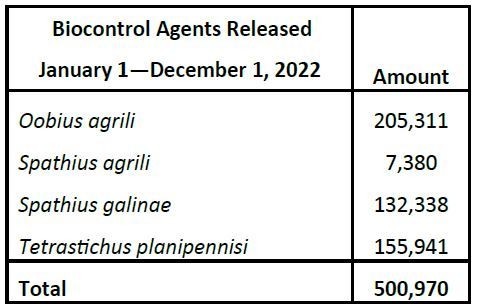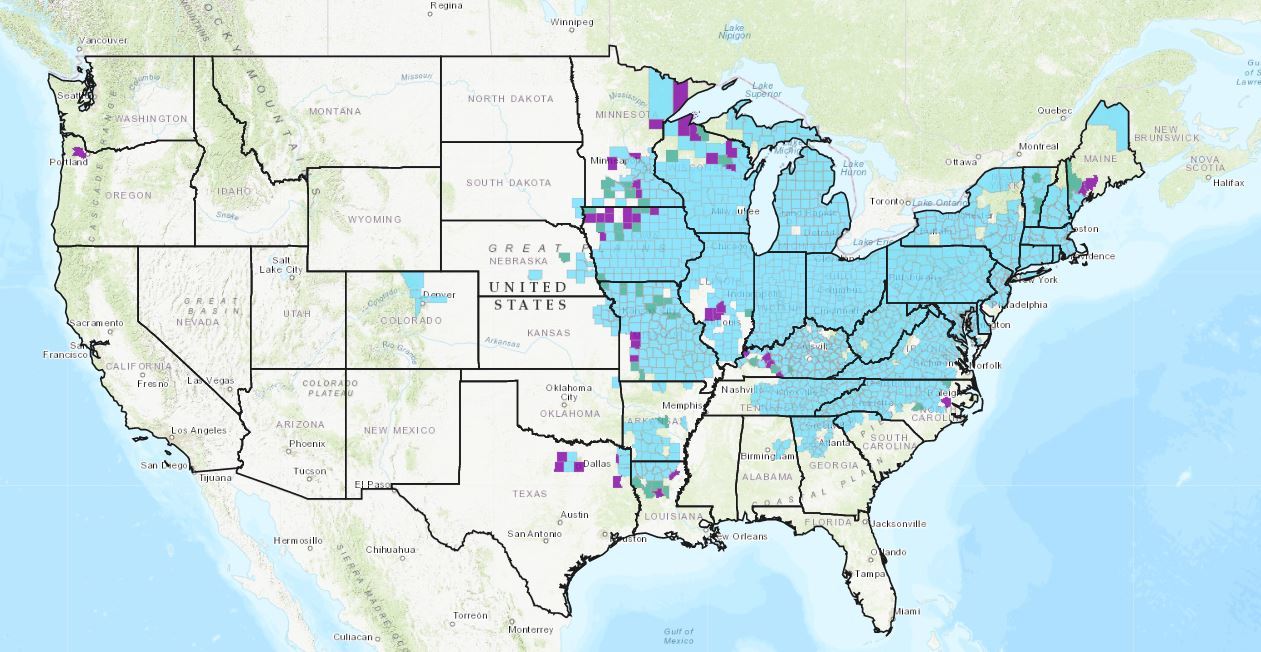USDA's Emerald Ash Borer Program Report Update | December 21, 2022
USDA Animal and Plant Health Inspection Service sent this bulletin at 12/21/2022 03:01 PM ESTHaving trouble viewing this email? View it as a Web page. ![]()
You are subscribed to Emerald Ash Borer Program Report for USDA Animal and Plant Health Inspection Service.

December 21, 2022
USDA’s Animal and Plant Health Inspection Service (APHIS) works with State, Federal, and other partners to detect and manage known emerald ash borer (EAB) infestations. The EAB program uses biological control and ongoing research to minimize the impact from an infestation and maintain ash as a viable part of the American landscape. This report provides the most current information on EAB program efforts.
Announcements
New Policy Manager
With over 20 years of experience working in APHIS’ Plant Protection and Quarantine program, Dr. Ron Weeks is the new National Policy Manager for Emerald Ash Borer, Biocontrol, Imported Fire Ant, Roseau Cane Scale, and South American Cactus Moth programs. He served as Acting EAB National Policy Manager earlier this year. Dr. Ron Weeks can be reached at 919-559-4311 or Ron.D.Weeks@usda.gov.
EAB in the United States
EAB is in 36 states and the District of Columbia: Alabama, Arkansas, Colorado, Connecticut, Delaware, Georgia, Illinois, Indiana, Iowa, Kansas, Kentucky, Louisiana, Maine, Maryland, Massachusetts, Michigan, Minnesota, Missouri, Nebraska, New Hampshire, New Jersey, New York, North Carolina, Ohio, Oklahoma, Oregon, Pennsylvania, Rhode Island, South Carolina, South Dakota, Tennessee, Texas, Vermont, Virginia, West Virginia, and Wisconsin.
The image above shows where EAB is in the United States, with the purple areas being found in 2022, the green areas being found in 2021, and the blue areas being found in 2002-2020. Click the image or click interactive map for more details.
Biological Control
USDA uses emerald ash borer's natural enemies as biocontrol agents—these tiny stingless wasps are showing promise in terms of protecting young ash saplings in a number of states.

Releases
During the 2022 season, APHIS together with biological control partners, released parasitoids in 27 new counties. Bringing the program’s total number of releases to 418 counties in 31 states and the District of Columbia.
Recoveries
To date, parasitoids have been recovered in 23 states: Colorado, Connecticut, Delaware, Illinois, Indiana, Iowa, Kentucky, Louisiana, Maine, Maryland, Massachusetts, Michigan, Minnesota, Missouri, New Hampshire, New Jersey, New York, Ohio, Pennsylvania, Rhode Island, Tennessee, Virginia, Wisconsin, and in 2 Canadian provinces: Ontario and Quebec. This means the wasps are establishing, reproducing, and killing EAB.
Guidelines
If you completed first-year releases in 2022, you will release the same parasitoids at the same sites again in 2023 since all parasitoid species receive two consecutive years of releases. For sites starting in 2023, approximately 100 new sites will be accepted for first year releases, and top priority will be given to new states and counties.
Requirements
All recovery data must be entered into MapBiocontrol.org as soon as possible but no later than 12 months after the final release in an area. A minimum sampling of one release site per county is required. If you have questions, please contact Russ Bulluck at 919-855-7182 or Russ.Bulluck@usda.gov.
To learn more about biological control releases, please visit APHIS’ EAB Program webpage. If you have questions, please call 1-866-322-4512 or email eab.biocontrol.program@usda.gov.
Research
APHIS scientists are studying how Integrated Pest Management (IPM) might be used in a forest ecosystem to significantly reduce and control EAB populations. IPM combines a variety of tools and strategies to identify, manage, and reduce risks and impacts from pests.
Trapping
APHIS is providing traps and lures to conduct surveys. You can request traps, lures, and accessories through your State Plant Regulatory Official or you can order them through the Integrated Plant Health Information System (IPHIS). Please remember to enter your survey data weekly into IPHIS.
Latest Maps
Infested Counties Map (Interactive)
Additional Resources
Informational Websites
EAB National Invasive Species Information Center
Outreach Materials
Contacts
EAB National Policy Manager
Ron Weeks, 919-559-4311
EAB National Operations Manager
Russ Bulluck, 919-855-7182
If you think you’ve found EAB or signs of infestation, record the area where the specimen was found and take digital pictures of the insect and tree damage. Submit your report to your State Plant Health Director, or email Report.EAB@usda.gov, or call the EAB hotline at 1-866-322-4512. Thank you.



